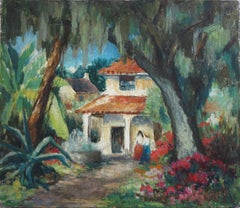Tod Lindenmuth On Sale
Recent Sales
1930s American Impressionist Landscape Paintings
Panel, Oil
Tod Lindenmuth for sale on 1stDibs
Tod Lindenmuth was a semi-abstract painter and graphic artist who did much to promote modernist styles. Although he was much influenced by Abstract Expressionism, his subject matter was realistic enough to be recognizable. He did linoleum cuts and was one of the first to work with that medium, and towards the end of his life, he experimented with collage. In the 1930s, he had commissions for the Public Works of Art Project and the Works Progress Administration. Lindenmuth was born in Allentown, Pennsylvania. He studied with Robert Henri at the New York School of the Arts in Manhattan, and in Provincetown with E. Ambrose Webster and George Elmer Browne. He first exhibited in Provincetown in 1915 and between 1917 and 1928 served on the jury for the Provincetown Art Association’s "First Modernistic Exhibition.” He exhibited regularly with the Society of Independent Artists in New York. He married artist and illustrator Elizabeth Boardman Warren, whom he met in Provincetown, and with whom he had two children. They were both very active in Provincetown, but in 1934, they visited St. Augustine, Florida, for the first time and went on to establish a winter studio in the Fatio House on Aviles Street and became active and respected members of the arts community there. In 1940, the couple moved permanently to St. Augustine. They never owned a car and sought subjects on long walks around St. Augustine. In 1940, Lindenmuth turned away from graphic arts and focused on landscape painting. One of his landscapes, Spanish Cedar and Live Oak along the Moat, St. Augustine, depicted a huge tree on a historic site whose excavations showed that St. Augustine had an early role in validating Spanish claims to North America. In 1940, the Lindenmuth's moved their summer studio from Provincetown to Rockport, Massachusetts, and became regular exhibitors of the Rockport Artist Association. He once said, “the marine subjects of Provincetown and Rockport, Massachusetts, are favorite painting spots but the landscape of the South with its subtle and tropical aspects furnishes a lot of material for the artist, particularly around St. Augustine.” For the remainder of their painting careers, they divided their time seasonally between Rockport and St. Augustine. In 1968, they retired to Jacksonville, Florida, living in Wesley Manor (Westminster Woods) on Julington Creek. Lindenmuth died in Jacksonville in 1976 at age 91.
Finding the Right landscape-paintings for You
It could be argued that cave walls were the canvases for the world’s first landscape paintings, which depict and elevate natural scenery through art, but there is a richer history to consider.
The Netherlands was home to landscapes as a major theme in painting as early as the 1500s, and ink-on-silk paintings in China featured mountains and large bodies of water as far back as the third century. Greeks created vast wall paintings that depicted landscapes and grandiose garden scenes, while in the late 15th century and early 16th century, landscapes were increasingly the subject of watercolor works by the likes of Leonardo da Vinci and Fra Bartolomeo.
The popularity of religious paintings eventually declined altogether, and by the early 19th century, painters of classical landscapes took to painting out-of-doors (plein-air painting). Paintings of natural scenery were increasingly realistic but romanticized too. Into the 20th century, landscapes remained a major theme for many artists, and while the term “landscape painting” may call to mind images of lush, grassy fields and open seascapes, the genre is characterized by more variety, colors and diverse styles than you may think. Painters working in the photorealist style of landscape painting, for example, seek to create works so lifelike that you may confuse their paint for camera pixels. But if you’re shopping for art to outfit an important room, the work needs to be something with a bit of gravitas (and the right frame is important, too).
Adding a landscape painting to your home can introduce peace and serenity within the confines of your own space. (Some may think of it as an aspirational window of sorts rather than a canvas.) Abstract landscape paintings by the likes of Korean painter Seungyoon Choi or Georgia-based artist Katherine Sandoz, on the other hand, bring pops of color and movement into a room. These landscapes refuse to serve as a background. Elsewhere, Adam Straus’s technology-inspired paintings highlight how our extreme involvement with our devices has removed us from the glory of the world around us. Influenced by modern life and steeped in social commentary, Straus’s landscape paintings make us see our surroundings anew.
Whether you’re seeking works by the world’s most notable names or those authored by underground legends, find a vast collection of landscape paintings on 1stDibs.
